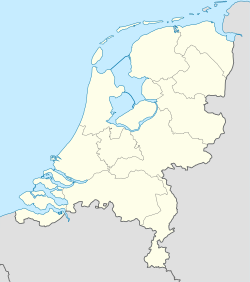Top Qs
Timeline
Chat
Perspective
Hegebeintum
Village in Friesland, Netherlands From Wikipedia, the free encyclopedia
Remove ads
Hegebeintum (Dutch: Hogebeintum) is a small village in Noardeast-Fryslân in the province of Friesland, the Netherlands. It had a population of around 90 in January 2017.[3] Before 2019, the village was part of the Ferwerderadiel municipality.[4]
Hegebeintum is home to the highest artificial dwelling hill, or terp, in the Netherlands, measuring around 8.8 metres (29 ft) tall.[4] The high ground of the terp was historically used as a place of refuge during unusually high tides and storm floods, and also had a number of dwellings. There is a well-known restored windmill located south of the village: the Hegebeintumer Mûne.
Remove ads
History
The village was first mentioned between 819 and c. 825 as Bintheim, and means "high settlement with moor grass (Molinia).[5] Hegebeintum is a terp village with a near perfect radial structure. It developed several centuries before Christ. The Dutch Reformed church dates from the 12th century. It was enlarged around 1550. The 13th-century tower was rebuilt in 1717 with yellow bricks.[6]
The polder mill Hegebeintumer Mûne was built in 1860. In 1969, it was decommissioned, because nobody was willing to move to Hegebeintum to operate wind mill, and a pumping station was installed. In 2006, it has been designated as a backup system.[7]
In 1840, Hegebeintum was home to 190 people.[4] Between 1896 and 1905, parts of the terp were excavated which has resulted in a very steep hill.[6] The old terp used to cover 9.5 hectares (23 acres).[4]
Remove ads
Gallery
- Hegebeintum church
- Hegebeintumer Mûne
- Tour buses in Hegebeintum
- House in Hegebeintum
References
External links
Wikiwand - on
Seamless Wikipedia browsing. On steroids.
Remove ads










